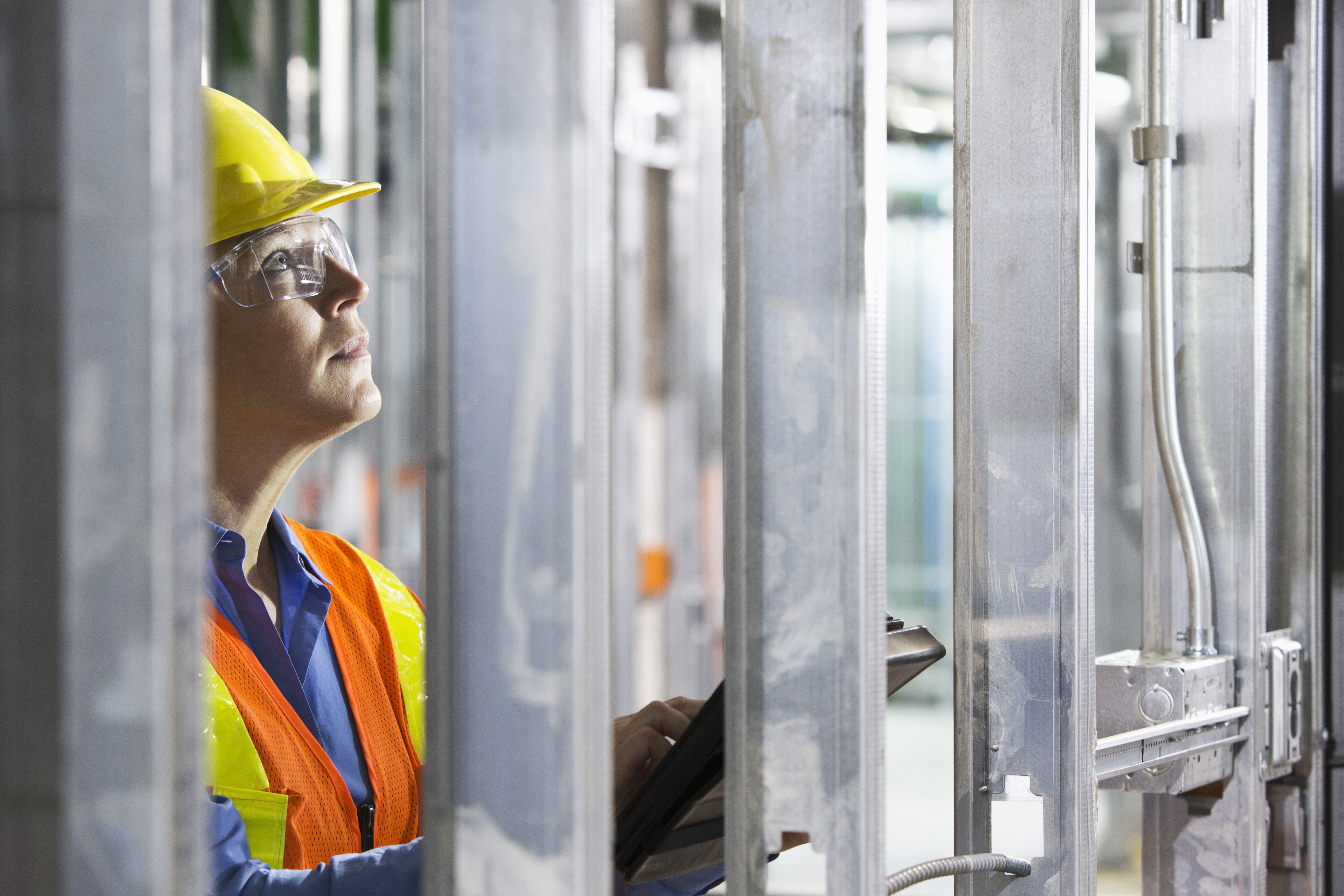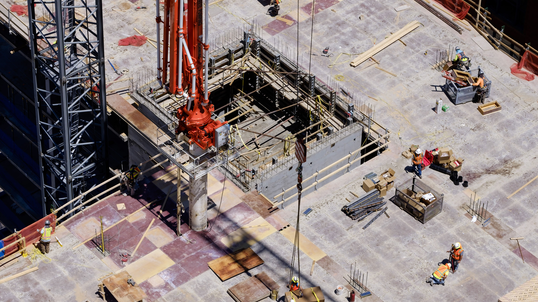Environmental Challenges to Manage When Constructing High-Tech Manufacturing Facilities

(SPEECH)
[MUSIC PLAYING]
(DESCRIPTION)
Logo: Travelers. Text: Environmental Risk, Construction for High-Tech Manufacturing Facilities. Hard hats and high tech. Water trickles over a microchip. Text: Alyson Jacobs, Practice Lead, Environmental and Contractors Professional Practice, Travelers.
(SPEECH)
ALYSON JACOBS: The surging U.S. demand for sophisticated electronics is driving an increase in the need for domestic manufacturing facilities to produce cutting-edge technology.
(DESCRIPTION)
Rectangular panels travel down assembly lines in a factory. A person uses a soldering iron to assemble a microchip.
(SPEECH)
This emphasizes how important it is for domestic construction teams to understand the realities of these facilities and their environmental impact. Ambitious plans are underway for domestic production of advanced new semiconductors, electric vehicles, renewable energy components and more, along with the factories needed to produce these technologies. These plans promise significant opportunities but also great environmental challenges.
[MUSIC PLAYING]
(DESCRIPTION)
Text: Environmental risks and elevated exposures.
(SPEECH)
High-tech manufacturing facilities involve large, complex construction processes with specialized materials and chemicals, which can harm the environment if not properly mitigated.
(DESCRIPTION)
A person sprays foam insulation on a wall. Side-by-side footage depicts a cloudy blue sky, a fish leaping from water and a person holding a handful of rich soil.
(SPEECH)
Contractors need to recognize these risks and prioritize air, water and soil quality along with environmental safety practices. Consider the following environmental risks in the construction of sophisticated manufacturing plants.
[MUSIC PLAYING]
(DESCRIPTION)
Text: Air quality and advanced construction. Aerial footage of a massive factory appears.
(SPEECH)
Air pollution is a major concern in the construction of modern manufacturing facilities, due to the use of specialized solvents and chemicals, which often contain volatile organic compounds that can contribute to poor air quality.
(DESCRIPTION)
A person sprays a clear varnish over a metal panel. Text: Specialized solvents and chemicals create environmental risks. An excavator gathers a load of large rocks in its clawed arm, then deposits them in the back of a truck.
(SPEECH)
Additionally, construction activities such as excavation, grading and demolition can release dust, including silica and other toxic particulates.
(DESCRIPTION)
A dusty material falls from a chute onto the quarry ground below.
(SPEECH)
Retrofitting or expanding existing facilities into high-tech manufacturing plants increases air quality risks due to the disturbance of hazardous materials, such as asbestos fibers and lead dust.
(DESCRIPTION)
A man drills into a wall while wearing a respirator. Another man puts on a respirator and protective goggles.
(SPEECH)
Ensuring air quality requires construction teams to adopt strict safety measures and be equipped with the appropriate tools and training to handle these challenges effectively.
[MUSIC PLAYING]
(DESCRIPTION)
Text: H20 and High-Tech Builds. Sunlight travels beneath an ocean's surface and illuminates the water below.
(SPEECH)
Water pollution is a significant risk during the construction of sophisticated facilities.
(DESCRIPTION)
A red and black iridescent substance pours out from a pipe onto the ground. Text: Chemicals, paints and other materials can contaminate water.
(SPEECH)
Chemicals and metals from paints, coatings and other materials can enter local waterways and compromise water quality if not properly managed.
(DESCRIPTION)
Heavy rain falls.
(SPEECH)
Also, the use of fuels, lubricants, soils and hydraulic fluids in construction equipment can impact stormwater runoff, leading to water pollution.
(DESCRIPTION)
A girl drinks a glass of water.
(SPEECH)
Contaminants from these substances pose risks to public health. Effective management practices are crucial to prevent these substances from entering nearby water bodies, highlighting the essential role of construction teams in implementing these measures.
[MUSIC PLAYING]
(DESCRIPTION)
Text: Soil hazards and sophisticated sites. Iridescent oil spreads across rocky soil. People walk across a construction site.
(SPEECH)
The use of construction materials and equipment for complex builds can lead to leaks, spills or improper disposal of specialized fuels, oil, solvents or chemicals, allowing these substances to seep into the soil.
(DESCRIPTION)
An excavator digs into mud. Text: Leaks and spills of hazardous chemicals create serious jobsite risks.
(SPEECH)
Drips from machinery, accidental spills and inadequate storage contribute to soil contamination.
(DESCRIPTION)
A person uses a tool to spray a paved roadway. A man coughs into his hand while he works in a dust-filled building under construction.
(SPEECH)
The shortage of qualified workers in the U.S. can result in less experienced workers being assigned to critical projects, which can increase the risk of pollution conditions related to improper implementation of safety procedures or controls.
(DESCRIPTION)
A doctor examines a scan of a person's lungs.
(SPEECH)
Thorough training in handling, storage and disposal of hazardous materials or waste is essential for managing these potential exposures effectively.
[MUSIC PLAYING]
(DESCRIPTION)
Text: Experience and expertise. Two constructor workers eye a tablet as they have a conversation in a building under construction.
(SPEECH)
Travelers Construction risk control specialists are well-versed in the nuances of mitigating pollution risks during construction of high-tech manufacturing facilities.
(DESCRIPTION)
Text: Specialized coverage options for every contractor's needs. Two construction workers smile and shake hands, then examine a tablet.
(SPEECH)
They can assist our customers, address potential hazards and make recommendations to help customers take action before a costly cleanup is required. With our menu of coverage options, customers can tailor a program to their specific needs. Whether a large general contractor or a specialized trade contractor, we work with each customer to create a solution that meets their goals.
(DESCRIPTION)
Logo: Travelers.
(SPEECH)
To learn more about how Travelers supports the construction of high-tech manufacturing facilities, connect with your independent agent or visit travelers dot com slash construction.
[MUSIC PLAYING]
(DESCRIPTION)
Talk to your independent agent or visit travelers dot com slash construction. © 2025 The Travelers Indemnity Company. All rights reserved. Travelers and the Travelers Umbrella logo are registered trademarks of The Travelers Indemnity Company in the U.S. and other countries.
The expansion of high-tech manufacturing across the United States means more opportunities for contractors who can build specialized facilities to house sophisticated operations. However, significant environmental risks may add to the inherent complexity of constructing large and technically advanced structures. Working with and around potentially hazardous materials, equipment and waste requires adherence to strict codes, regulations and specifications, as well as specialized knowledge, skills and experience.
Factors that could increase pollution hazards on high-tech manufacturing construction projects.
Inexperience and knowledge gaps
For contractors, branching out to high-tech construction may require training in the proper handling of hazardous materials and waste disposal, as well as proficiency in the relevant building codes, techniques and sustainability practices. From soil and groundwater contaminated by spills, leaks or seepage, to injuries due to contact with toxic chemicals, particulates or fumes, any failure to identify or properly mitigate environmental exposures could result in a pollution liability claim.
Project complexity
Environmental issues at high-tech facilities are sometimes traced back to failures when interpreting or implementing complex design drawings and specifications. Starting work before properly addressing questions or concerns about the project plan, including the potential environmental impact, could ultimately leave contractors at risk for pollution liability. Understanding project requirements and getting the appropriate sign-offs on any deviations from initial designs – such as product or material substitutions, recommended building or installation techniques, equipment used and other value engineering decisions that were made – may help offset these risks.
Imperfect facility site conditions
Whether breaking new ground, constructing over an abandoned lot or expanding the footprint of an existing structure, one of the greatest risks of a high-tech build can be from the facility grounds. Even if a contractor is not involved in the site selection process, they could be held liable for environmental impacts and non-compliance resulting from unknown or unintentional ecosystem disruptions or legacy pollution. Responsibility to remediate preexisting environmental conditions and help prevent new ones, as well as reduce the impact on surrounding habitats and communities, could fall to the contractor. If unaware or unprepared, the contractor may be at risk of liability.
Hazardous materials and waste handling, storage and disposal
Asbestos, adhesives, diesel fuels, flame retardants, halogenated compounds, refrigerants, resins, solvents and more – high-tech operations and associated construction activities often necessitate working around or coming into contact with hazardous materials and potentially harmful waste. Contractors face unique environmental challenges in building, installing or utilizing structures and systems to store, contain or transport and dispose of hazardous substances and waste used in the construction of high-tech facilities. Completing projects in ways that limit exposures to hazardous materials, both during and after construction, is key to minimizing risk.
Deficiencies in commissioning process
Environmental exposures often come to light in the critical final stages of a high-tech manufacturing facility build. Careful planning and execution of commissioning and turnover activities – including participation in or oversight of the first production run – can help prevent costly setbacks. Testing and verifying that the build went according to plan and demonstrating that your team properly disposed of waste, handled hazardous materials conscientiously and followed regulations diligently throughout construction may help minimize liability for remediation or environmental damage, among other things.
Proactive project planning and management can help minimize high-tech environmental risks.
Environmental challenges in the construction of high-tech manufacturing facilities can vary greatly depending on the nature of the structure, the construction processes, the materials and equipment used and the existing environmental conditions at the building site. Following these key best practices can support mitigating risks related to environmental exposures on high-tech builds.
- Select projects carefully, evaluating each opportunity to ensure it involves teams with a proven track record in delivering high-tech projects with minimal environmental impact.
- Participate in project planning discussions, particularly those addressing the potential environmental impact of the project, including construction materials or methods.
- Diligently monitor project teams and progress to support compliance efforts with environmental regulations, design specifications, safety data sheets, safe handling guidelines and waste management requirements.
- Keep and retain records, including change orders and sign-offs, official inspection reports, material safety and equipment-operating manuals, and evidence of adherence to environmental safety standards.
- Follow rigorous quality assurance and control practices, such as inspecting materials prior to installation, using third parties to test and validate environmental compliance or deploying technology to help identify and address potential environmental issues.
- Use contracts to effectively transfer risk, ensuring that each includes clearly defined liability, subrogation, indemnification or hold harmless clauses and environmental compliance requirements and responsibilities. Discuss appropriate pollution liability limits and coverages with your agent and an attorney familiar with these unique exposures.
High-tech builds demand high-quality insurance solutions.
Comprehensive coverage from a carrier with experience and expertise helping to mitigate environmental challenges can be one of the most powerful tools on a high-tech construction job. For example, Travelers works collaboratively with contractors to help minimize environmental risks that can lead to bodily injury, property damage, pollution cleanup costs and claims for other potential liability. By doing so, companies can focus on capitalizing on high-tech opportunities and growing their business.
Standard Commercial General Liability policies exclude coverage for most pollution claims, but Travelers supports contractors with industry-leading ECP CustomSM Contractors Pollution Liability insurance coverage and dedicated risk control specialists who support clients through guidance and consultation on environmental hazards and related best practices.
To learn more about Travelers innovative insurance and risk management solutions for construction companies, contact your agent.



